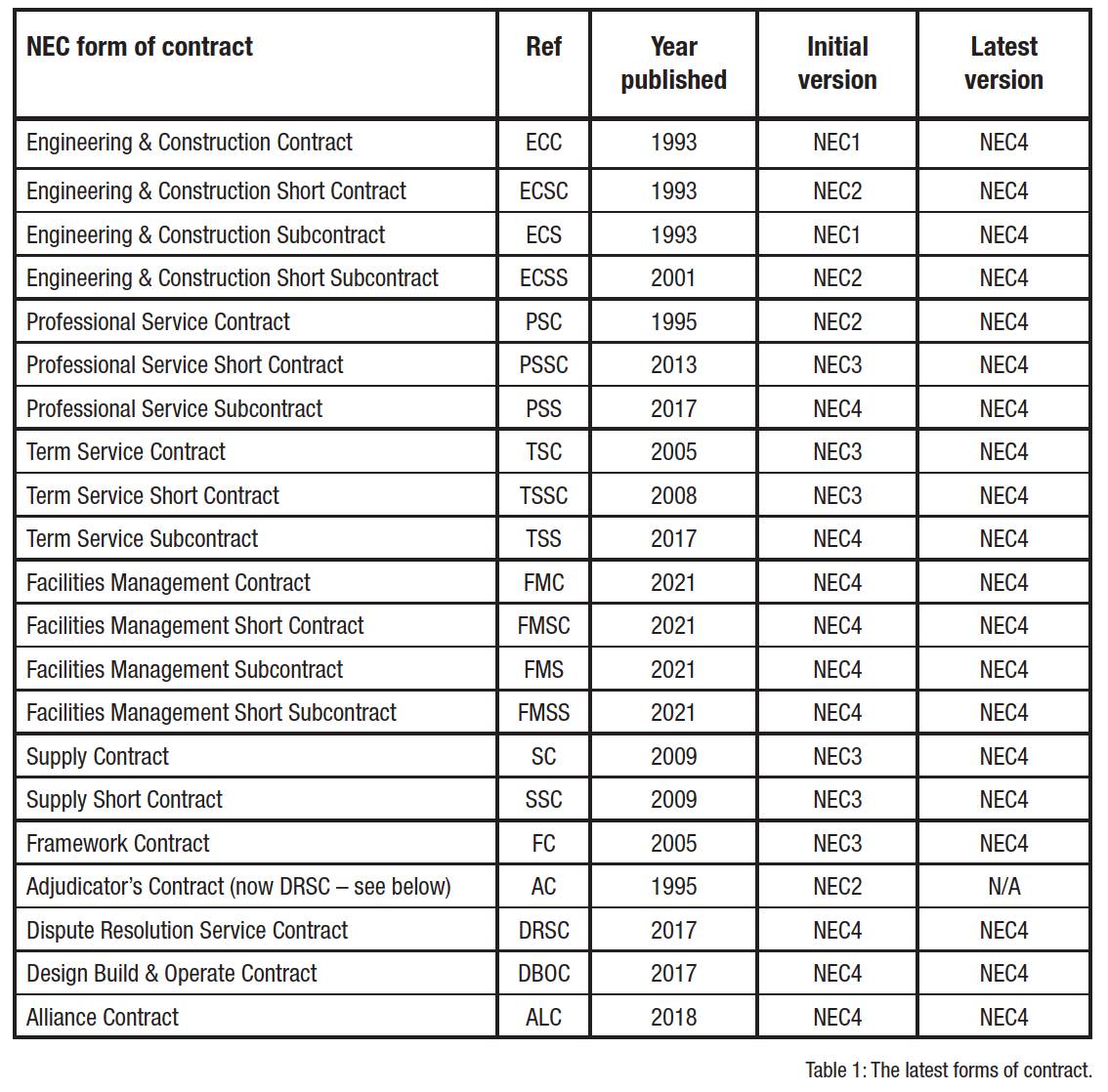NEC X options: Introduction
Andrew Wooldridge-Irving, Associate Director and Alex Tolson, Assistant Quantity Surveyor, GVE

IN 1993 a new standard form of contract was introduced titled the New Engineering Contract (NEC).
Although the name was changed in 1995, with the publication of the 2nd edition, to the Engineering and Construction Contract, the NEC name continued as a broad reference to the family of associated contracts.
The latest version, referred to as NEC4, was published in June 2017 and comprises the following forms of contract shown in Table 1.

The NEC contracts have been designed with three main objectives in mind, which are:
- Flexibility
- Clarity and simplicity
- Stimulus to good management.
The objective of flexibility is demonstrated by the range of standard NEC options, that are designed for use with the contracts and allow for an applicable form to be modified to suit a particular approach. Although they are described as options, some of these are not optional but mandatory, providing for a selection of alternative choices, whereas other options are entirely discretionary.
Main options
Main options: These are denoted by the letters A through to F and apply a particular commercial arrangement and risk allocation between the parties.
These are denoted by the letters A through to F and apply a particular commercial arrangement and risk allocation between the parties. These options add bespoke clauses which supplement the core conditions of contract and apply to the following NEC forms:
A – Priced contract with activity schedule – ECC ECS PSC PSS TSC TSS FMC FMS
B – Priced contract with bill of quantities – ECC ECS
C – Target contract with activity schedule – ECC ECS PSC PSS TSC TSS FMC FMS
D – Target contract with bill of quantities – ECC ECS
E – Cost reimbursable contract – ECC ECS PSC PSS TSC TSS FMC FMS
F – Management contract – ECC
Where the main options apply to an applicable NEC form, one of these must be selected.
W options
The dispute resolution provisions are either incorporated as part of the conditions of contract, at core clause 9, or as W options, with the W options applying to the following NEC forms:
W1 – ECC ECS PSC PSS TSC TSS FMC FMS DBOC
W2 – ECC ECS PSC PSS TSC TSS FMC FMS DBOC
W3 – ECC
For NEC forms with main options they are also referred to as main options and for NEC forms without main options they are simply referred to as options. These W options apply in the same way as main options in that an appropriate dispute resolution procedure must be selected.
X options
These can be selected to supplement the core contract conditions. For NEC forms with main options they are referred to as secondary options and for NEC forms without main options they are simply referred to as options. The X options apply to the following NEC forms:
X1 – Price adjustment for inflation – ECC ECS PSC PSS TSC TSS FMC FMS SC
X2 – Changes in the law – ECC ECS PSC PSS TSC TSS FMC FMS SC ALC
X3 – Multiple currencies – ECC ECS PSC PSS TSC TSS FMC FMS SC DBOC
X4 – Ultimate holding company guarantee – ECC ECS PSC PSS TSC TSS FMC FMS SC DBOC ALC
X5 – Sectional completion – ECC ECS PSC PSS
X6 – Bonus for early completion – ECC ECS PSC PSS
X7 – Delay damages – ECC ECS PSC PSS SC
X8 – Undertakings to the client – ECC ECS PSC PSS TSC TSS FMC FMS DBOC
X9 – Transfer of rights – ECC ECS PSC PSS FMC FMS DBOC ALC
X10 – Information modelling – ECC ECS PSC PSS TSC TSS FMC FMS SC DBOC ALC
X11 – Termination by the client – ECC ECS PSC PSS TSC TSS FMC FMS SC
X12 – Multiparty collaboration – ECC ECS PSC PSS TSC TSS FMC FMS SC
X13 – Performance bond – ECC ECS PSC PSS TSC TSS SC DBOC
X14 – Advanced payment – ECC ECS SC DBOC
X15 – The contractor’s design – ECC ECS
X16 – Retention – ECC ECS X17 – Low performance damages – ECC ECS TSC TSS SC
X18 – Limitation of liability – ECC ECS PSC PSS TSC TSS FMC FMS SC DBOC ALC
X19 – Termination by either party – TSC TSS FMC FMS
X20 – Key performance indicators – ECC ECS PSC PSS TSC TSS SC
X21 – Whole life cost – ECC ECS TSC TSS FMC FMS SC
X22 – Early contractor involvement – ECC ALC
X23 – Extending the service period – TSC TSS FMC FMS DBOC
X24 – The accounting periods – TSC TSS FMC FMS
X25 – Supplier warranties – SC
X26 – Programme of work – ALC
X27 – Project orders – FMC FMS
X28 – Change of control – FMC FMS.
In addition to the above option X29 – Reducing the impact of the works on climate change, was recently published as a consultative edition.
Y options
Unlike the main options and W options, X options are entirely optional and may be chosen to supplement the core conditions of contract.
These are used specifically when a project is subject to the authority and legislation of a particular jurisdiction. For NEC forms with main options they are referred to as secondary options and for NEC forms without main options they are simply referred to as options. For use in the United Kingdom there are specific Y(UK) options, as follows:
Y(UK)1 – Project Bank Account – ECC ECS PSC PSS TSC TSS FMC FMS SC ALC
Y(UK)2 – The Housing Grants, Construction and Regeneration Act 1996 – ECC ECS PSC PSS TSC TSS FMC FMS DBOC ALC
Y(UK)3 – The Contracts (Rights of Third Parties) Act 1999 – ECC ECS PSC PSS TSC TSS FMC FMS SC DBOC ALC
In addition, there are also Y options for use in Australia, Y(Aus)1, and Ireland, Y(IR)1, published in March 2021.
Use of X options
Unlike the main options and W options, X options are entirely optional and may be chosen to supplement the core conditions of contract. Each X option is intended to provide a standalone procedure, although, due to an element of overlap in some instances, certain X options are not used with other specified X options. The wording of many X options changes according to which NEC contract form it applies to. This is partly to accommodate the different parties and named roles but also to align with the type of contract form and the associated procedures which apply.
One of the issues encountered during research for the articles, is the attention to detail needed to effectively incorporate the X options. Many of these require supplementary information to be populated in contract data and the scope, with careful consideration as to how this information interacts with both the option-specific procedure and the core contract conditions.
These options cover a wide variety of different topics which makes it challenging to accurately categorise them, although for the purposes of subsequent articles each X option has been organised according to the considered dominant theme.
Andrew Wooldridge-Irving, Associate Director and Alex Tolson, Assistant Quantity Surveyor, GVE
awooldridge–irving@gvecs.co.uk